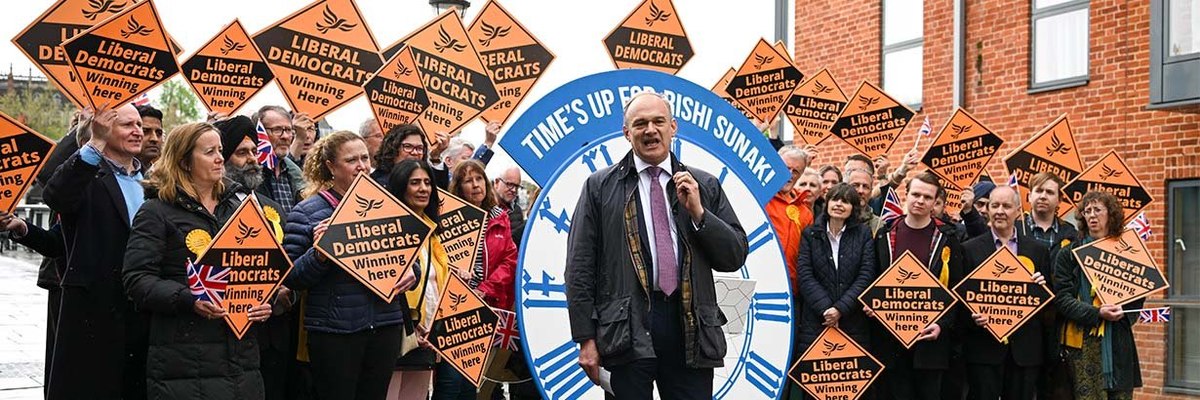In line with our projections, Labour make significant gains across marginal and Red Wall councils, as the Liberal Democrats sweep across the Blue Wall
In April YouGov projected local election outcomes in 18 English councils. Our ‘2023 battleground councils’ included a range of metropolitan, borough, and unitary councils up and down the country, from Darlington in the North East to Plymouth in the South West.
This was the first time we had used MRP – the tool used by YouGov to successfully predict the 2017 and 2019 general elections – to predict local elections.
Our overall story was that Labour would make strong advances across the councils in the so-called ‘Red Wall’, and also in many marginal councils and those covering Westminster bellwether constituencies.
We projected, however, that Labour would find advances in some areas more difficult than in others, highlighting that there is still some way to go on Labour’s long, uneven road to recovery from the disaster of the 2019 general election. We also expected the Liberal Democrats to do well in a number of councils across the South and East of England.
In the end, the results played out in exactly that fashion. Labour made advances and took key councils up and down the North and Midlands, and made statement wins in Plymouth and Medway in the South.
The Liberal Democrats swept to victory in many key areas around the London commuter belt, including Winchester, Windsor and Maidenhead, and Dacorum.
Council by council performance
With the final results now in, it is possible to analyse the accuracy of each of YouGov’s MRP calls across the 18 councils. In each council, YouGov gave an overall call (who, if anyone, we projected to control the council after the results were in), and a note on the general story that the data was telling us (such as ‘modest Labour gains’, which would indicate Labour making progress in terms of increasing its vote share and perhaps also in seats).
Successful projections included each of Dartford, Dudley, Hyndburn, Milton Keynes, Plymouth, Rugby, Sheffield, Sunderland, Swindon, and Wokingham.
There were other councils where the call didn’t reflect the eventual result, but which were extremely close to the story we told. These included Windsor and Maidenhead and Darlington, where the final figures came within a hairsbreadth of reflecting the call (and the story was in line with the given notes).
There were a further few councils where the call was not correct, but the story in the note was accurate. This list includes Chichester, Worcester, and North East Lincolnshire (where Labour gains in the urban areas comprising the Red Wall seat of Great Grimsby and Cleethorpes constituencies were particularly strong). Finally, in Mid Suffolk the Greens significantly outperformed our model’s expectations to take control of the council by six seats. While we anticipated the Greens had a very good chance of winning the council, we did not accurately capture the momentum with which they would do so.
Unfortunately, the remaining two councils were not all that accurately captured by the model. Labour did not make significant gains in Walsall, which remained in Conservative control by a margin of seven seats. In East Cambridgeshire, both parties made slight advances in terms of vote share across a good number of wards, but the overall position remains pretty much exactly how it was before Thursday’s vote.
Overall assessment
Local elections are notoriously hard to predict. Hyper-local factors and street-by-street stories can, and do, impact voter behaviour at such a micro-level that it is extremely difficult for models and forecasters to detect.
Theoretically, the advantages of MRP in its ability to detect and account for local-level variation in voter behaviour should make it a strong tool for projecting local authority elections. On the evidence of YouGov’s 2023 model this would seem to bare out.
In fact, looking across the various forecasts and expectations set pre-election, our model was among the most accurate – if not the most accurate – of the story of the 2023 local elections.
In his summary of pollster performance, Mark Pack (President of the Liberal Democrats) stated that his calculation of YouGov’s accuracy represented “a pretty good score - and one that shows how the overall picture was painted correctly by YouGov”.
Of course, there is absolutely room for improvement. The model particularly struggled to pick out the scale of advances by the Green Party – especially where they were coming from a relatively low baseline. As it turned out, this underestimate of the Greens held the model back not only from projecting their wins and gains, but also meant we slightly overrepresented Labour’s progress in some of their target areas including Worcester and Darlington.
We also did not measure advances for the Liberal Democrats as accurately as we would have liked. In some areas, such as East Cambridgeshire, we overstated their progress. In others, such as Chichester, we underestimated it.
A more accurate assessment of both Liberal Democrat and Green performances will be key to improving the model ahead of future election cycles.
Photo: Getty








